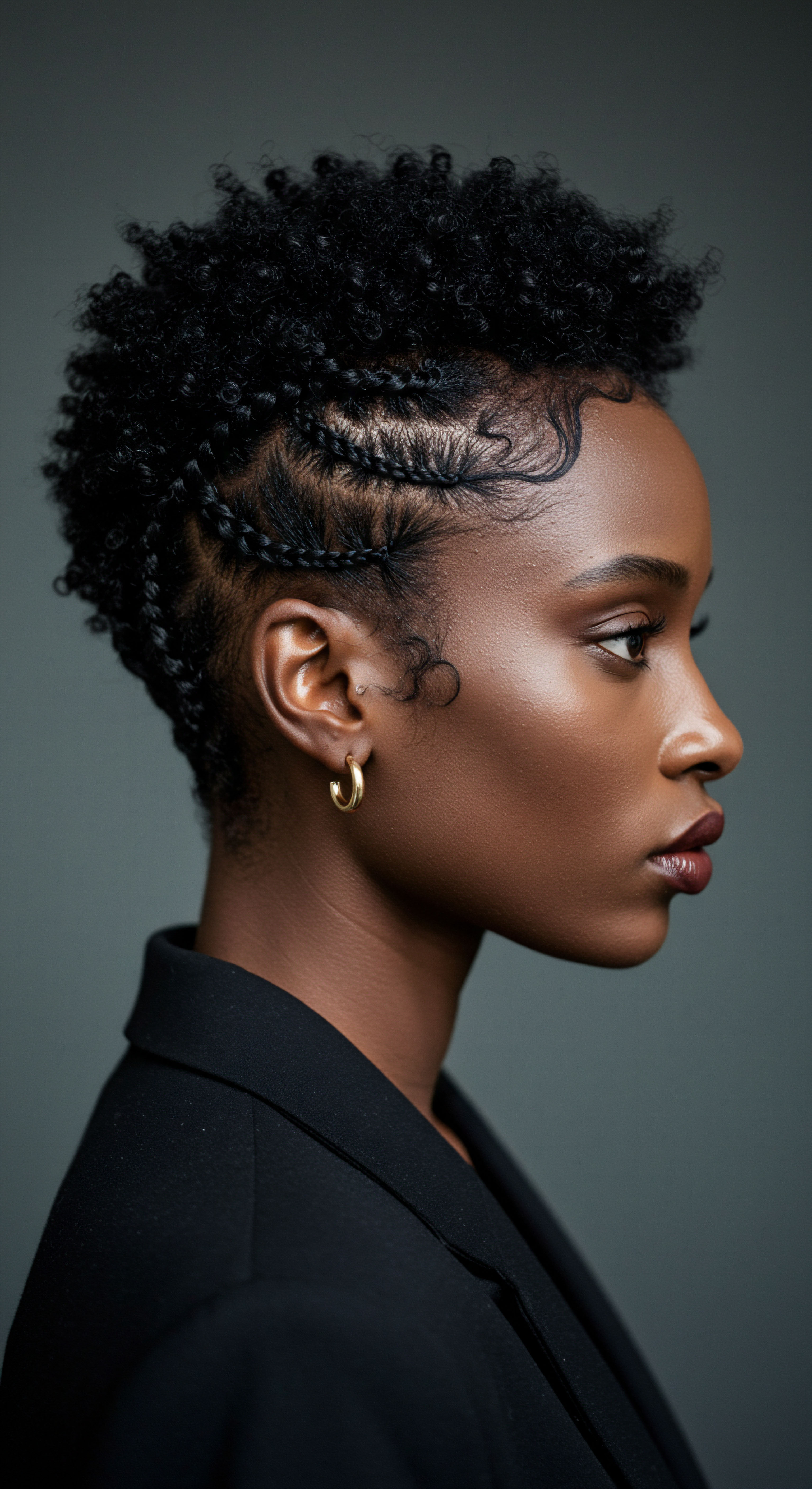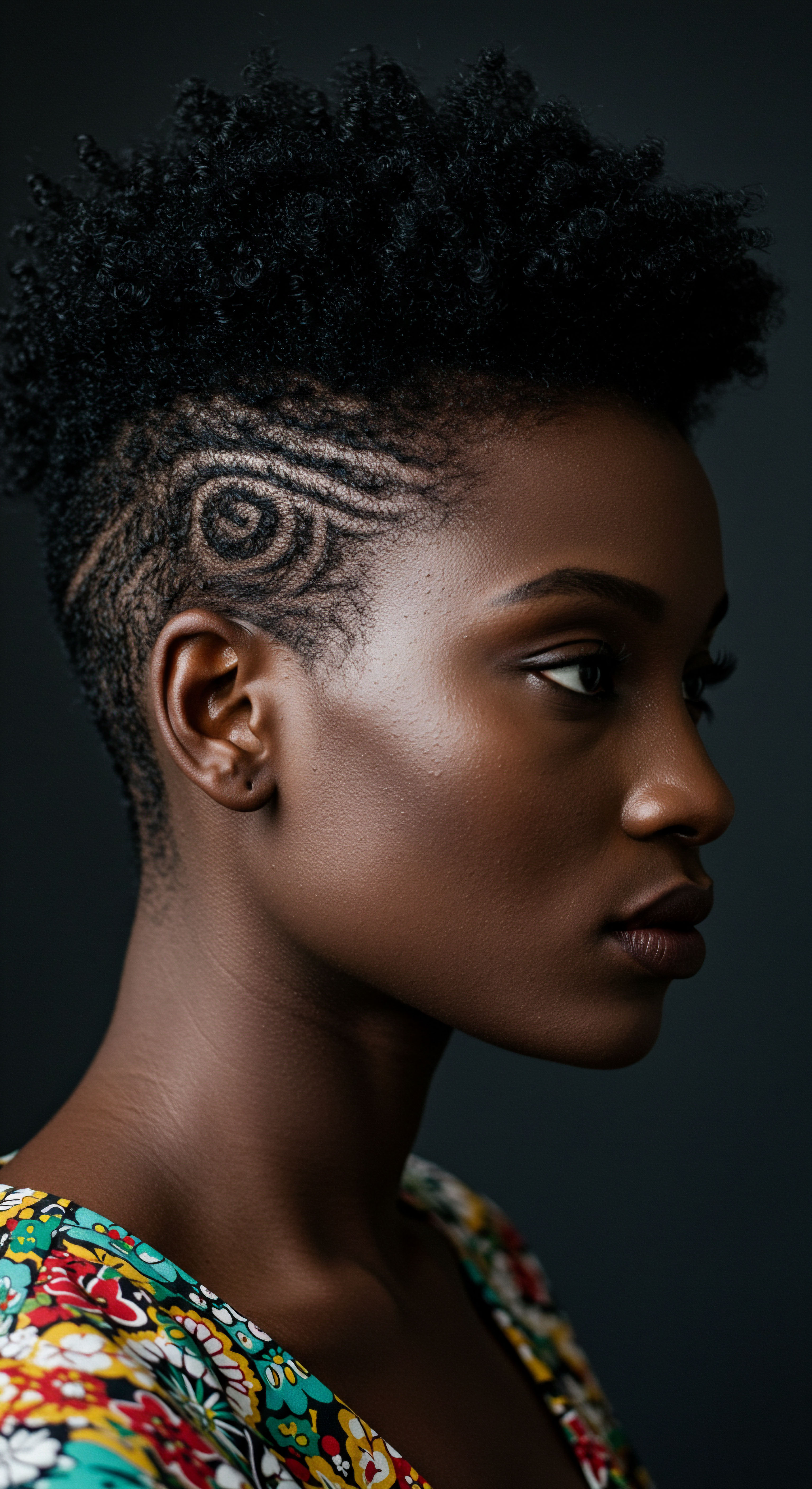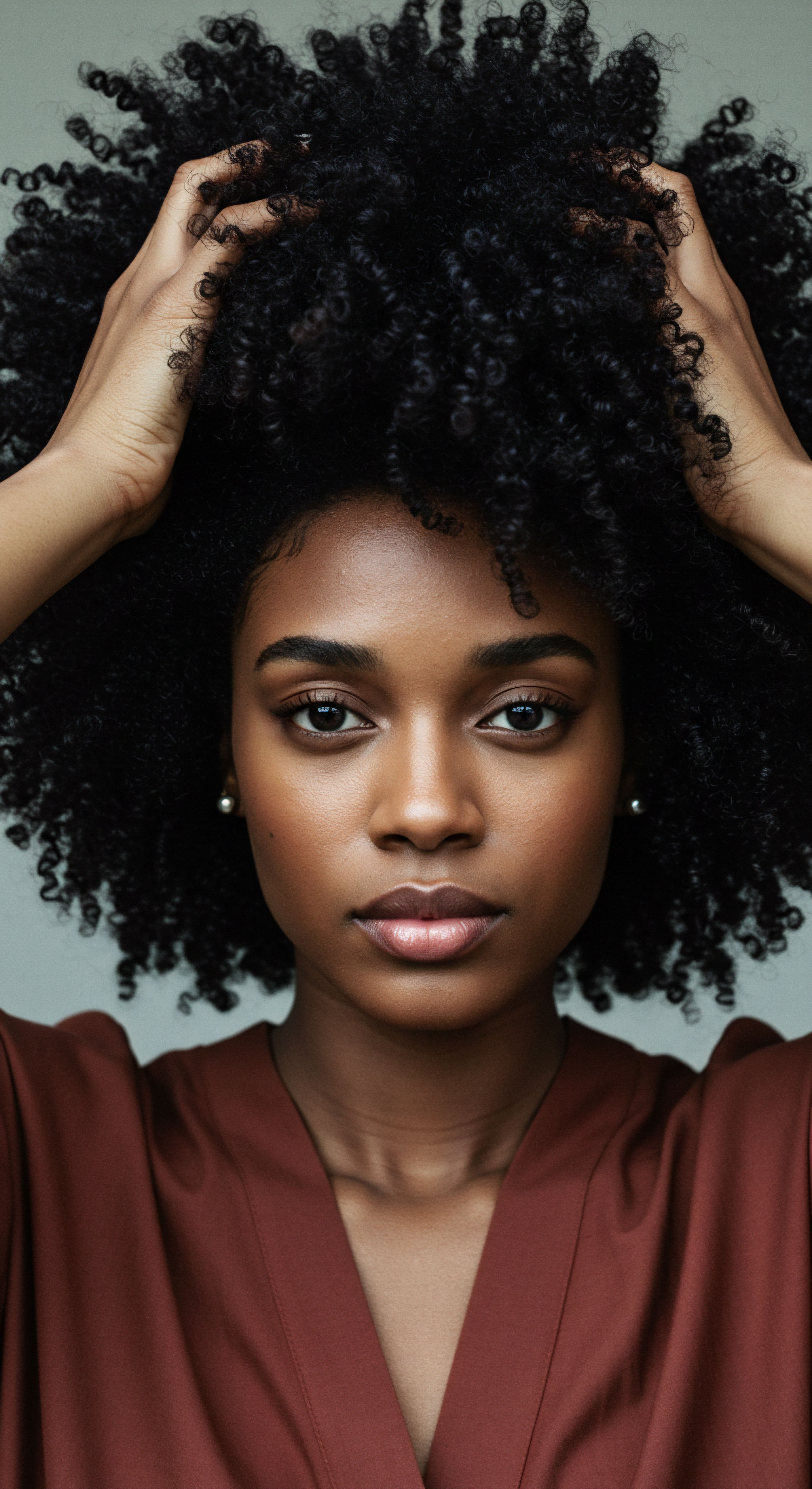
Roots
Consider the quiet wisdom held within the earth, the gentle hum of life that courses through every leaf and stem. Before the shimmering bottles and vibrant tubes of our modern age, there existed a deep, intuitive knowing—a connection to the very ground beneath our feet. For generations, across continents and through the whispers of time, humans turned to the natural world for sustenance, for healing, and yes, for beauty. This journey into the ancient ways of hair coloring begins not with a product, but with a simple leaf, a dried root, a crushed berry.
It is an invitation to understand how the earth itself offered its hues, allowing individuals to adorn themselves, to signify status, to honor rites of passage, or simply to express a personal spirit. These early practices were more than just cosmetic applications; they were a dialogue with nature, a testament to human ingenuity, and a reflection of cultural values that saw beauty intertwined with the living world.
The foundational plant materials that lent their pigments to human hair represent a botanical palette, each offering a distinct spectrum of shades and properties. These were not synthetic concoctions, but organic gifts, carefully harvested and prepared to coax forth their vibrant potential. Understanding these ancient dyes means peering into the heart of early botanical knowledge, where observation and experimentation led to remarkable discoveries. The efficacy of these natural agents lay in their complex chemical structures, which, when properly extracted and applied, could interact with the hair’s own protein matrix to deposit lasting color.

The Earth’s Palette Ancient Hair Pigments
Among the most celebrated and enduring of these botanical contributions stands Henna, derived from the Lawsonia inermis plant. This shrub, native to North Africa, the Middle East, and parts of Asia, has a history stretching back millennia. Its leaves, when dried and powdered, yield a rich reddish-orange dye molecule known as lawsone. When lawsone comes into contact with the keratin protein in hair, it binds to it, creating a permanent stain.
The resulting shade can range from a fiery copper to a deep auburn, depending on the hair’s original color, the quality of the henna, and the application process. Henna was not just a dye; it held symbolic meaning in many cultures, associated with blessings, good fortune, and celebration.
Ancient societies discovered a vibrant palette of hair colors directly from the earth’s botanical offerings.
Working in concert with henna, or often used independently for darker tones, was Indigo, sourced from plants of the Indigofera genus, particularly Indigofera tinctoria. This plant is famed for producing a deep blue pigment. Unlike henna, indigo does not stain the hair through direct binding; instead, it adheres to the outer layers of the hair shaft.
When applied after henna, or mixed with it, indigo reacts with the reddish tones to produce shades ranging from rich browns to profound blacks. The alchemy of combining these two powerful plant dyes allowed ancient colorists to achieve a broad spectrum of natural-looking dark hues, transforming hair into a canvas of deep, earthy tones.
Beyond these two titans, other plant materials offered their unique contributions. Walnut Hulls, specifically from the Juglans regia tree, provided a natural brown to black dye. The green outer husks of walnuts contain juglone, a potent brown-staining compound. This pigment, when extracted, could darken hair effectively, creating shades that were both deep and enduring.
Similarly, the common Chamomile flower, Matricaria chamomilla, was prized for its gentle lightening properties. Infusions of chamomile flowers, particularly when exposed to sunlight, could impart subtle golden highlights to lighter hair, a testament to the delicate artistry of ancient hair practices.
For those seeking more vibrant, warm tones, Saffron, derived from the stigmas of the Crocus sativus flower, offered a precious golden hue. While saffron was often reserved for special occasions or for those of high status due to its rarity and cost, its ability to impart a delicate yellow-orange tint was recognized and utilized. Another source of reddish-brown tones was Rhubarb Root, Rheum rhabarbarum, which, when prepared correctly, could yield warm, reddish-blonde to light brown shades, particularly on lighter hair.

How Did Ancient People Discover These Plant Pigments?
The discovery of these dyeing properties likely unfolded through generations of careful observation and accidental revelation. Early humans, intimately connected to their environment, would have noticed how certain plant materials stained their hands, clothing, or cooking utensils. The trial and error involved in processing plants for food, medicine, or textiles would have naturally led to the understanding of their pigmentary capabilities.
This empirical knowledge, passed down through oral traditions and practical demonstration, formed the bedrock of ancient cosmetic arts. The preparation of these materials often involved crushing, boiling, fermenting, or steeping, processes that would liberate the dye molecules from the plant matter.
- Observation ❉ Early communities noticed how plant juices and extracts stained skin, fabric, and hair.
- Experimentation ❉ Through trial and error, they refined methods of extraction and application.
- Tradition ❉ Knowledge of effective plant dyes was passed down, becoming integral to cultural practices.
The ingenuity displayed in harnessing these natural resources for hair coloring speaks volumes about the holistic approach ancient societies took to well-being and adornment. They understood that beauty was not separate from nature, but an extension of its inherent splendor.

Ritual
Stepping from the foundational knowledge of plant materials, we now approach the sacred space of ritual—the ‘how’ of ancient hair coloring. This was seldom a fleeting act; rather, it often embodied a thoughtful process, interwoven with daily rhythms or significant life events. Imagine the quiet preparation, the meticulous grinding of dried leaves, the careful mixing with warm water or other natural agents, transforming powdered earth into a potent paste.
This was practical wisdom in motion, a testament to hands-on skill and a deep respect for the botanical gifts being utilized. The methods employed were as varied as the cultures themselves, yet a common thread of deliberate action and patient waiting connected them all, elevating a simple cosmetic treatment to a moment of focused care and intention.
The efficacy of ancient plant-based hair dyes depended not only on the raw materials but also on the intricate processes of preparation and application. These techniques, refined over centuries, were often guarded secrets, passed down through families or within specialized communities. The transformation of a humble plant into a potent coloring agent required a sophisticated understanding of chemistry, even if it was empirical rather than theoretical.

Preparation of Ancient Hair Dyes
The initial step for many plant dyes involved preparing the raw material. For Henna, dried leaves were ground into a fine powder. This powder would then be mixed with a liquid, often warm water, to form a thick paste. The acidity of the liquid could influence the dye release; acidic mediums like lemon juice, strong tea, or vinegar were sometimes added to facilitate the release of lawsone, the dye molecule.
This mixture would then be allowed to ‘dye release’ for several hours, or even overnight, in a warm environment. This waiting period was crucial, allowing the lawsone molecules to migrate from the plant matter and become available for binding with hair keratin.
Indigo preparation followed a different path. Unlike henna, indigo’s blue pigment is not directly present in the leaves. It exists as a colorless precursor called indican, which, through fermentation and oxidation, transforms into indigotin, the blue dye. For hair dyeing, dried indigo leaves were also powdered.
When mixed with water, the indigotin would adhere to the hair’s surface. To achieve deeper black tones, indigo was almost always applied after henna, or mixed with henna, creating a two-step process or a single-step ‘henndigo’ application. The exact ratios and timing were often matters of practiced skill and cultural tradition.
Other plant materials had their own unique preparation rituals. Walnut Hulls, for example, might be crushed and boiled to extract the juglone, forming a strong decoction that could be used as a rinse or a paste. Chamomile was typically prepared as a strong infusion, steeped in hot water, and then allowed to cool before being used as a hair rinse, often combined with exposure to sunlight to enhance its lightening effects.
The deliberate preparation of plant materials transformed them into potent coloring agents, a meticulous process honed over generations.

Application Techniques and Cultural Contexts
Once prepared, the application of these natural dyes was a hands-on affair. The paste or liquid was meticulously applied to the hair, often section by section, ensuring even coverage. For henna, the thick paste would be worked through the hair, from root to tip, and then coiled or braided, often covered with a cloth or leaves to maintain warmth and moisture, facilitating better dye uptake. The dye would remain on the hair for several hours, sometimes even overnight, before being rinsed out.
The act of hair coloring was frequently imbued with cultural and social significance. In many ancient societies, hair was more than just strands; it was a powerful symbol of identity, status, spirituality, and even fertility. Changing its color could mark significant life transitions, such as coming of age, marriage, or mourning.
- Symbolism ❉ Hair color changes could signify status, tribal affiliation, or life stages.
- Celebration ❉ Vibrant hair was often part of festive occasions and rites.
- Protection ❉ Some believed certain dyes offered spiritual protection.
In ancient Egypt, both men and women used henna to color their hair, often to mask graying hair or to enhance their natural red or brown tones. The hair of mummies frequently shows evidence of henna application, preserving the ancient practice. In ancient Rome, women often experimented with various shades, using plant dyes to achieve blonde, red, or black hair, sometimes to emulate the popular styles of Germanic or Gallic captives. The dyeing process could be a social event, performed within family units or by skilled artisans.
The meticulousness of these ancient rituals, from the careful grinding of botanicals to the patient waiting for the color to develop, underscores a profound respect for the transformative power of nature. These practices were not just about changing a hair shade; they were about connecting with ancestral wisdom, celebrating personal expression, and participating in a legacy of natural adornment.
| Plant Material Lawsonia inermis (Henna) |
| Primary Preparation Dried, powdered leaves mixed with acidic liquid to form a paste. |
| Typical Hair Color Range Red, Orange, Auburn, Brown (when combined) |
| Plant Material Indigofera tinctoria (Indigo) |
| Primary Preparation Dried, powdered leaves mixed with water; often applied after henna. |
| Typical Hair Color Range Blue, Brown, Black (when combined with henna) |
| Plant Material Juglans regia (Walnut Hulls) |
| Primary Preparation Crushed green hulls boiled to create a decoction or paste. |
| Typical Hair Color Range Dark Brown, Black |
| Plant Material Matricaria chamomilla (Chamomile) |
| Primary Preparation Dried flowers steeped in hot water to create an infusion. |
| Typical Hair Color Range Golden Blonde, Subtle Highlights |
| Plant Material These natural preparations offered a diverse spectrum of shades for ancient hair adornment. |

Relay
Having explored the fundamental plant sources and the intricate rituals of ancient hair coloring, we now move to a deeper understanding—a relay of knowledge that connects the botanical with the biological, the cultural with the chemical. This is where the strands of history, science, and identity intertwine, revealing the profound layers beneath a seemingly simple act of adornment. It invites us to consider not just what was used, but why it worked, how it shaped perceptions, and what echoes of these practices resonate even today. The ancient world, in its sophisticated approach to natural dyes, laid down a foundation that speaks volumes about human connection to environment and self.
The effectiveness of ancient plant dyes rests upon the delicate dance between the dye molecules and the hair’s protein structure. Hair, primarily composed of keratin, presents a complex canvas. The specific way a plant dye interacts with keratin determines its color, permanence, and overall effect. This biological interplay is a testament to the empirical scientific understanding possessed by ancient practitioners, even without modern microscopes or chemical analyses.

How Do Plant Pigments Interact With Hair Keratin?
At a microscopic level, hair strands are covered by an outer layer of overlapping scales called the cuticle. Beneath this lies the cortex, which contains the hair’s natural pigment, melanin, and its structural proteins. Plant dyes generally work in one of two primary ways ❉ by staining the cuticle layer or by penetrating slightly into the outer cortex.
Henna, with its lawsone molecule, offers a particularly durable bond. Lawsone is small enough to penetrate the cuticle and bind directly to the keratin proteins in the cortex. This binding creates a strong, permanent stain that does not wash out, but rather fades over time as the hair grows and the outer layers wear.
The warmth of the color is a result of lawsone’s reddish-orange hue, which combines with the hair’s natural melanin to create unique shades. This chemical interaction is why henna is so long-lasting and renowned for its conditioning properties, as it can temporarily plump the hair shaft.
Indigo, by contrast, functions more as a coating. Its larger dye molecules primarily deposit on the outer cuticle layer of the hair. This is why indigo alone might not be as permanent as henna and why it often requires a prior or concurrent application of henna to achieve darker, more stable shades.
The blue of indigo overlays the red of henna, producing browns and blacks. This layered application showcases an advanced understanding of color theory and dye layering long before these concepts were formalized.
The interplay between plant dye molecules and hair’s keratin structure determined the longevity and shade of ancient hair colors.

The Deeper Meanings of Ancient Hair Color
Beyond the chemical interactions, the act of coloring hair with plant materials carried profound cultural and social weight. Hair, as a visible and malleable aspect of one’s appearance, served as a canvas for expressing identity, status, and affiliation.
- Social Standing ❉ Certain colors or styles could denote wealth or societal rank.
- Spiritual Connection ❉ Hair practices often linked to religious beliefs or protective charms.
- Group Identity ❉ Shared hair colors could signify belonging to a specific tribe or community.
In ancient Rome, for example, hair color held complex meanings. While blonde hair was sometimes associated with courtesans, it also became fashionable for noblewomen, who would lighten their hair using various concoctions, including plant extracts like saffron and chamomile, or even harsh bleaches. Red hair, often achieved with henna or similar plant-based dyes, was sometimes associated with vitality or specific ethnic groups. The desire for darker hair was also prevalent, particularly among men and women seeking to appear younger or to mask graying.
A compelling, albeit perhaps controversial, example of ancient hair coloring practices involves the use of plant dyes in conjunction with metallic compounds to achieve desired shades, particularly darker ones. Historical accounts and archaeological findings suggest that in some ancient societies, including Rome, people combined plant extracts with mineral salts to enhance color depth and permanence. For instance, texts describe mixtures that included ingredients like Lead Acetate, sometimes referred to as ‘sugar of lead’, alongside plant-derived dyes such as walnut hulls or galls. When lead acetate reacts with sulfur in hair keratin, it can produce lead sulfide, a black compound.
This practice, while effective in achieving dark, lustrous tones, carried inherent health risks due to lead toxicity, a fact not fully understood at the time. A study published in the Journal of Archaeological Science analyzing Roman hair samples has revealed traces of lead, supporting the historical accounts of such combined applications. This highlights a nuanced aspect of ancient beauty practices ❉ a drive for aesthetic perfection sometimes intersected with materials whose long-term effects were unknown, a subtle echo of the choices we still navigate in modern beauty.

What Did Hair Color Signify in Ancient Societies?
The spectrum of meaning attached to hair color was vast. In some cultures, maintaining a youthful appearance through hair dyeing was a sign of vitality and status. In others, specific colors were used during mourning periods, or as part of initiation rites.
The careful application of plant dyes was not merely a superficial act; it was often a deeply symbolic gesture, connecting the individual to their community, their ancestors, and the very rhythms of the natural world. The relay of this knowledge, from generation to generation, ensured that these profound connections endured, making the history of hair color a vibrant thread in the broader tapestry of human cultural expression.
| Ancient Culture/Region Ancient Egypt |
| Associated Hair Colors Red, Auburn, Dark Brown (often henna) |
| Symbolic Meanings Youth, Vitality, Masking Graying, Religious Rites |
| Ancient Culture/Region Ancient Rome |
| Associated Hair Colors Blonde, Red, Black (various plant and mineral mixes) |
| Symbolic Meanings Fashion, Social Status, Emulation of Foreign Styles |
| Ancient Culture/Region Ancient India |
| Associated Hair Colors Red, Brown, Black (primarily henna and indigo) |
| Symbolic Meanings Auspiciousness, Celebration, Ritual Cleansing |
| Ancient Culture/Region Ancient Greece |
| Associated Hair Colors Blonde (often achieved with plant washes) |
| Symbolic Meanings Beauty, Youth, Divine Association |
| Ancient Culture/Region Hair color choices in antiquity reflected diverse social, spiritual, and aesthetic values. |

Reflection
As we gently close the exploration of ancient hair coloring, a quiet appreciation for the ingenuity and deep connection to nature of our ancestors remains. The vibrant hues coaxed from leaves, roots, and berries were more than just pigments; they were expressions of identity, symbols of belonging, and reflections of a world where beauty was sourced directly from the earth. These historical practices invite us to consider our own relationship with adornment, perhaps prompting a pause to appreciate the simpler, more profound ways of nourishing and enhancing our hair. The echoes of ancient wisdom remind us that true beauty often lies in harmony with the natural world, a timeless truth that continues to whisper through the strands of our textured hair.

References
- Lucas, A. Ancient Egyptian Materials and Industries. Dover Publications, 1999.
- Pliny the Elder. Natural History. Translated by H. Rackham, W.H.S. Jones, and D.E. Eichholz. Harvard University Press, 1938-1962.
- Sanyal, M. et al. “Dyeing of Human Hair with Natural Dyes.” Journal of Textile and Apparel, Technology and Management, vol. 6, no. 1, 2009, pp. 1-10.
- Knutson, C. A. “Hair Dyes from Plants.” Journal of Chemical Education, vol. 72, no. 11, 1995, pp. 977-979.
- Walter, P. et al. “Lead and Hair Dye in Roman Times.” Journal of Archaeological Science, vol. 27, no. 3, 2000, pp. 241-244.
- Cardon, D. Natural Dyes ❉ Sources, Traditions, Technology and Colourants. Archetype Publications, 2007.
- Goodwin, J. A History of the Hair ❉ Fashion and Adornment. Penguin Books, 1999.
- Rastogi, S. C. et al. “Natural Hair Dyes ❉ A Review.” Journal of Pharmacy Research, vol. 5, no. 4, 2012, pp. 2221-2225.